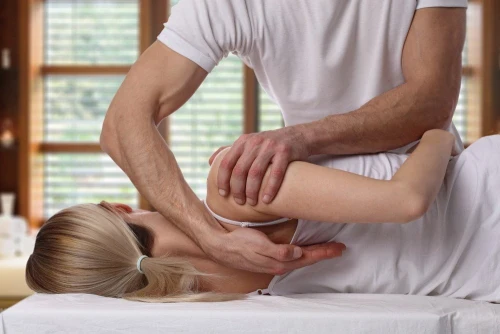On your first consultation, our Osteopaths will take a full Case History. This involves an in-depth discussion about your presenting complaint(s), questions on your general health, lifestyle and past medical history.
This consultation lasts from 30-45 minutes dependant on the complaint and patient. Any information you have on medication you may be taking, results of tests, scans or x-rays will be useful to the Osteopath.
Following the case history an examination will be carried out in which the Osteopath will look at your posture and ask you to perform a series of movements and tests so that the mobility of your body can be evaluated. To aid the Osteopath’s examination, you may be asked to remove some of your clothing. If you feel uncomfortable about this, you may bring a pair of shorts and a t-shirt to change into before your assessment. A gown will be provided, if desired. The Osteopath will do their best to respect your modesty. You are free to bring along a friend or relative with you to act as your chaperone at any time.
Dependent on the case history other medical, orthopaedic or neurological testing may be carried out. The Osteopath will explain these fully as they proceed. The Osteopath will use palpation, a highly developed sense of touch, to assess areas of weakness, tenderness, restriction or strain within your body and also perform various passive movements to your joints.
Once the examination is completed and in conjunction with all the other information that has been gleaned the Osteopath will arrive at a diagnosis. The osteopath will then explain in detail what has gone wrong and show you models, pictures and diagrams to aid your understanding.
At this point the Osteopath will give you an indication of how many treatments you are likely to need and how long it will take to improve your condition. The Osteopath will then be able to explain their treatment plan to you and proceed with the treatment. If the osteopath is concerned about the presence of a more serious underlying condition or if osteopathic treatment is not indicated, you will be referred to the most appropriate specialist/doctor for help and/or further investigations.
In most cases, some sort of treatment will be started on your first visit. Subsequent visits will be inevitably much more 'treatment orientated' and these may last up to 30 minutes. At the subsequent visits, the Osteopath will carefully monitor your progress and discharge you as soon as you have made a satisfactory recovery. If necessary, the Osteopath will provide a sick note and prepare Medical Reports at the request of your doctor or solicitor.
Treatment is different for every patient and depends on your age, fitness and diagnosis. Osteopaths use a variety of techniques including gentle manipulations, soft tissue massage and joint articulation to release tension, stretch muscles, help relieve pain and mobilise joints. The Osteopath will explain the techniques they are using.
During your consultations you will be given relevant advice. As Osteopaths, we are keen to find ways in which you can self manage the injury and therefore advice may be given on such areas as posture, ergonomics, diet and exercise. You will also be made aware of potential aggravating factors in your everyday life.
The Osteopath will be happy to answer any question at any point during the consultation or afterwards, over the telephone. We would rather explain something so that you do not worry or irritate your injury.
Professionalism and Safety
To qualify, an Osteopath must study for four to five years for an undergraduate degree. This is similar to a medical degree, with more emphasis on anatomy and musculoskeletal medicine and includes more than 1,000 hours of training in osteopathic techniques.
By law, Osteopaths must register with the General Osteopathic Council (GOsC). It is an offence for anyone to call themselves an Osteopath if they are not registered. The British Medical Association’s guidance for general practitioners states that doctors can safely refer patients to Osteopaths. On the 1st September 2012, the GOsC, published new guidelines that apply to all registered Osteopaths.
As always, we take pride in providing safe and effective treatment to all of our patients. Read more about the latest Standards Of Practice on the GOsC website.
GDPR
You can be assured that we will treat all your data and medical information with complete confidentiality and comply with General Data Protection Regulations (GDPR).
Massage Therapists
On your appointment, the Massage Therapist will discuss any issues or concerns at the start of your appointment. Assuming the Therapist has no concerns, the treatment can then commence.
Depending on the area to be treated, the Therapist may firstly ask you to remove the requird level of clothing to ensure the treatment can be as effective as possible. During this period the Therapist will wait outside of the room.
If you feel uncomfortable about this, you may bring a pair of shorts and a t-shirt to change into before your assessment. A gown will be provided, if desired. The Therapist will do their best to respect your modesty. You are free to bring along a friend or relative with you to act as your chaperone at any time.
Throughout the treatment the Therapist will check that you are comfortable and ensure the pressure of the massage is sufficient.
The treatment length will depend on the session you booked which range from 30 minutes to 60 minutes.
Once the treatment has finished the Massage Therapist will ask you if there are any problems or concerns. The Therapist will then step outside the room whilst you take your time to stand and get changed. The Therapist will then return to the room with some water for you and guide you back out to the recption area.
To find out more or speak to one of our team about any concerns or questions then please just contact us directly. You can also book a FREE 10 minute consultation.


